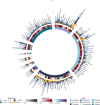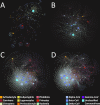Predicting mammalian hosts in which novel coronaviruses can be generated
- PMID: 33594041
- PMCID: PMC7887240
- DOI: 10.1038/s41467-021-21034-5
Predicting mammalian hosts in which novel coronaviruses can be generated
Abstract
Novel pathogenic coronaviruses - such as SARS-CoV and probably SARS-CoV-2 - arise by homologous recombination between co-infecting viruses in a single cell. Identifying possible sources of novel coronaviruses therefore requires identifying hosts of multiple coronaviruses; however, most coronavirus-host interactions remain unknown. Here, by deploying a meta-ensemble of similarity learners from three complementary perspectives (viral, mammalian and network), we predict which mammals are hosts of multiple coronaviruses. We predict that there are 11.5-fold more coronavirus-host associations, over 30-fold more potential SARS-CoV-2 recombination hosts, and over 40-fold more host species with four or more different subgenera of coronaviruses than have been observed to date at >0.5 mean probability cut-off (2.4-, 4.25- and 9-fold, respectively, at >0.9821). Our results demonstrate the large underappreciation of the potential scale of novel coronavirus generation in wild and domesticated animals. We identify high-risk species for coronavirus surveillance.
Conflict of interest statement
The authors declare no competing interests.
Figures



Comment in
- Reply to: Machine-learning prediction of hosts of novel coronaviruses requires caution as it may affect wildlife conservation.Nat Commun. 2022 Sep 12;13(1):5102. doi: 10.1038/s41467-022-32747-6.Nat Commun. 2022.PMID: 36096883Free PMC article.No abstract available.
- Machine-learning prediction of hosts of novel coronaviruses requires caution as it may affect wildlife conservation.Nat Commun. 2022 Sep 12;13(1):5101. doi: 10.1038/s41467-022-32746-7.Nat Commun. 2022.PMID: 36096892Free PMC article.No abstract available.
Similar articles
- Recent evolutionary origin and localized diversity hotspots of mammalian coronaviruses.Elife. 2024 Aug 28;13:RP91745. doi: 10.7554/eLife.91745.Elife. 2024.PMID: 39196812Free PMC article.
- SARS-CoV-2 and Three Related Coronaviruses Utilize Multiple ACE2 Orthologs and Are Potently Blocked by an Improved ACE2-Ig.J Virol. 2020 Oct 27;94(22):e01283-20. doi: 10.1128/JVI.01283-20. Print 2020 Oct 27.J Virol. 2020.PMID: 32847856Free PMC article.
- LY6E Restricts Entry of Human Coronaviruses, Including Currently Pandemic SARS-CoV-2.J Virol. 2020 Aug 31;94(18):e00562-20. doi: 10.1128/JVI.00562-20. Print 2020 Aug 31.J Virol. 2020.PMID: 32641482Free PMC article.
- Properties of Coronavirus and SARS-CoV-2.Malays J Pathol. 2020 Apr;42(1):3-11.Malays J Pathol. 2020.PMID: 32342926Review.
- The zoonotic potential of bat-borne coronaviruses.Emerg Top Life Sci. 2020 Dec 11;4(4):353-369. doi: 10.1042/ETLS20200097.Emerg Top Life Sci. 2020.PMID: 33258903Review.
Cited by
- Understanding the Role of Environmental Transmission on COVID-19 Herd Immunity and Invasion Potential.Bull Math Biol. 2022 Sep 10;84(10):116. doi: 10.1007/s11538-022-01070-y.Bull Math Biol. 2022.PMID: 36088430Free PMC article.
- Variations in cell-surface ACE2 levels alter direct binding of SARS-CoV-2 Spike protein and viral infectivity: Implications for measuring Spike protein interactions with animal ACE2 orthologs.bioRxiv [Preprint]. 2021 Oct 22:2021.10.21.465386. doi: 10.1101/2021.10.21.465386.bioRxiv. 2021.Update in: J Virol. 2022 Sep 14;96(17):e0025622. doi: 10.1128/jvi.00256-22.PMID: 34729559Free PMC article.Updated.Preprint.
- Divide-and-conquer: machine-learning integrates mammalian and viral traits with network features to predict virus-mammal associations.Nat Commun. 2021 Jun 25;12(1):3954. doi: 10.1038/s41467-021-24085-w.Nat Commun. 2021.PMID: 34172731Free PMC article.
- A roadmap towards predicting species interaction networks (across space and time).Philos Trans R Soc Lond B Biol Sci. 2021 Nov 8;376(1837):20210063. doi: 10.1098/rstb.2021.0063. Epub 2021 Sep 20.Philos Trans R Soc Lond B Biol Sci. 2021.PMID: 34538135Free PMC article.Review.
- Viral genomic features predict Orthopoxvirus reservoir hosts.bioRxiv [Preprint]. 2024 Dec 12:2023.10.26.564211. doi: 10.1101/2023.10.26.564211.bioRxiv. 2024.Update in: Commun Biol. 2025 Feb 26;8(1):309. doi: 10.1038/s42003-025-07746-0.PMID: 37961540Free PMC article.Updated.Preprint.
References
- He JF, et al. Molecular evolution of the SARS coronavirus, during the course of the SARS epidemic in China. Science. 2004;303:1666–1669. - PubMed
- Guan Y, et al. Isolation and characterization of viruses related to the SARS coronavirus from animals in Southern China. Science. 2003;302:276–278. - PubMed
- Rota PA, et al. Characterization of a novel coronavirus associated with severe acute respiratory syndrome. Science. 2003;300:1394–1399. - PubMed
Publication types
MeSH terms
Associated data
Grants and funding
LinkOut - more resources
Full Text Sources
Other Literature Sources
Miscellaneous

